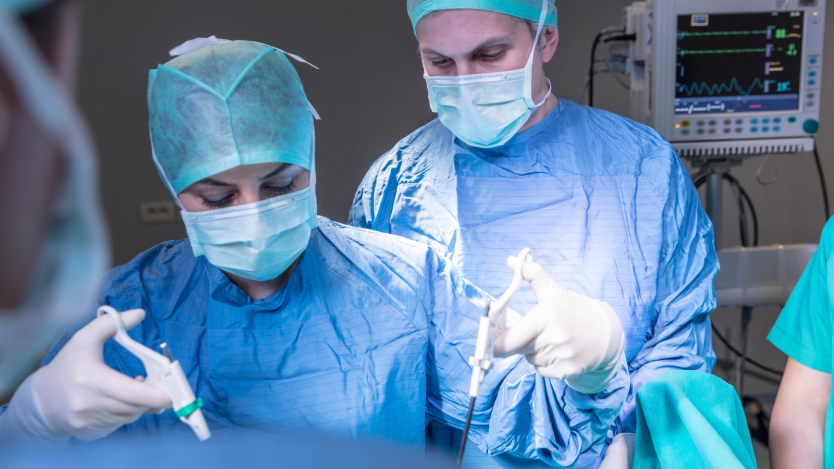Navel hernia in adults: Is surgery necessary?

- What is a navel hernia?
- How are abdominal hernias classified?
- How do umbilical hernias form?
- What are the risk factors for umbilical hernia?
- What are the symptoms of navel hernia?
- How is navel hernia diagnosed?
- How is umbilical hernia treated?
- What should you do before navel hernia repair surgery?
- What happens on the day of surgery?
- What will happen to you after surgery?
- Navel hernias in adults are quite common and the ultimate solution is surgical repair.
- There are a number of risk factors that favour the appearance of navel hernias, such as BMI.
- Navel hernia surgery can be performed with different techniques and we talk about them in this article.
How are abdominal hernias classified?

Abdominal hernias are classified according to their location and can be:
Internal, i.e. protrusions into a compartment in the abdominal cavity. These hernias cannot be seen from the outside.
External, which can be seen from the outside:
- Inguinocrural: inguinal and femoral hernias.
- Ventral: umbilical, epigastric, Spiegel, postincisional.
Abdominal hernias are clinically classified as follows:
- Congenital, i.e. the problem already exists when the baby is born.
- Acquired: the abdominal weakness appears over time.
- Recurrent: the hernia appears on the site of a previous hernia.
- Reducible: it can be pushed back into the abdominal cavity
- Incarcerated: the hernia is trapped by the abdominal muscles
- Strangulated: the hernia is irreducible, there is blockage of the intestinal transit and of the irrigation of the herniated intestine, and the viscera can become necrotic, gangrenous and perforated.
Depending on the content of the hernia sac, a distinction is made:
- Displacement: the hernia is composed of the contents of the abdominal cavity.
- Richter: contains only part of the bowel wall
- Littré: contains a Meckel's diverticulum
- Amyand: contains the appendix cecalis with or without appendicitis
Depending on the size of the hernia we can speak of:
- Small hernias (less than 2 centimetres).
- Medium-sized hernias (between 2 and 4 centimetres)
- Large hernias (larger than 4 centimetres)
How do umbilical hernias form?
An umbilical hernia develops when abdominal pressure pushes the intestines or other tissues through a weak area near the navel. First the abdominal lining protrudes through the weak area and begins to form the hernial sac.
The sac at this stage may contain fat, intestine or other tissues and at this point the hernia may or may not cause visible bulging.
Subsequently the intestine pushes further into the sac and a visible bulge forms. At this stage, when the patient lies down or pushes the hernia inwards, it may flatten out. This is called a reducible hernia and does not cause any immediate danger.

Later on, the sac containing the intestine may become trapped by the muscle of the abdominal wall, i.e. it may become incarcerated. At this stage the bulge can no longer be crushed and the pathology is called irreducible umbilical hernia.
The main symptom at this stage is pain and immediate treatment is often necessary.
If the intestine is strongly trapped, it becomes strangulated. The strangulated area loses blood supply and may become necrotic. If this happens the patient will have severe pain and intestinal blockage. Surgical intervention is urgently needed to relieve the obstruction.
What are the risk factors for umbilical hernia?
Some factors facilitate the development of navel hernias:
- Obesity with BMI greater than 35
- Chronic cough
- Chronic Obstructive Pulmonary Disease (COPD)
- Cystic fibrosis
- Smoking
- Heavy lifting, overexertion
- Malnutrition
- Obstructive Urinary Tract Disease
- Ascites
- Constipation
- Prostate disease
- Pregnancy
How is umbilical hernia treated?
The only and definitive treatment for navel hernia is surgery. The abdominal wall is made up of layers of muscle, fat and other tissues. These layers are responsible for giving strength to the abdominal wall.
During the surgical intervention the aim is to repair the weakness in the muscle and connective tissue. This prevents the intestines or other tissues from protruding once again. During traditional repairs an incision is made over the hernia. The weakened muscle tissue is sewn together. The top layers are closed.

The other option is the tension-free abdominal wall repair with mesh. In this case the abdominal muscle is not sutured, but a mesh covers the weakened area like a patch. In this case there is no tension on the muscles.
Recovery after this surgery is quicker and less painful.
Over time, nearby tissues grow into the mesh to reinforce the repair. Mesh repair, depending on the placement of the mesh, can be:
- Front repair: In this case a mesh patch is placed in front of the weakened area, the patch is sutured to nearby tissues to hold it in place.
- Rear repair: The mesh patch is placed behind the weakened area and sutured to nearby tissues. In this case the pressure inside the abdomen helps keep the patch in place.
- Combined repair: The mesh patches are placed in front of and behind the weak area.
Surgery can be open or laparoscopic. During open surgery, an incision is made above or below the navel until the hernia defect is reached. The surgeon will reposition the viscera inside the abdomen by pushing it inwards. The mesh is then placed and the incision is closed.
When the surgery is laparoscopic, 3 or 4 small incisions are made in the abdomen. The mesh is inserted with the help of the laparoscope through these small incisions. After the mesh has been placed correctly, the incisions are closed with stitches.

Do you need umbilical hernia surgery?
Request a free and immediate appointment with our specialists in General Surgery
What happens on the day of surgery?

- You will be asked to change into a hospital gown.
- An intravenous line will be started to give you medication and fluids.
- The surgical site will be disinfected.
- You will be given anaesthesia.
- The surgery will be performed. Get to know the step-by-step of the umbilical hernia operation.
What will happen to you after surgery?
- You will first be taken to the recovery area to rest.
- Your blood pressure and heart rate will be monitored.
- You will be given pain medication to control pain.
- You may go home when your surgeon tells you to.
- Follow your surgeon's instructions regarding rehabilitation.
Call your doctor if you notice swelling, bleeding, increasing pain, fever above 38°C, trouble urinating, nausea, vomiting, redness or drainage from your incision.

Do you need umbilical hernia surgery?
Request a free and immediate appointment with our specialists in General Surgery
Medical disclaimer: All the published content in Operarme is intended to disseminate reliable medical information to the general public, and is reviewed by healthcare professionals. In any case should this information be used to perform a diagnosis, indicate a treatment, or replace the medical assessment of a professional in a face to face consultation. Find more information in the links below:

